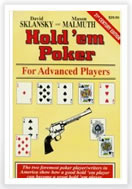 |
Authors: David Sklunsky, Mason Malmuth Publisher: Two Plus Two Pages: 332 Pub. Date: 1999 (3rd edition) Price: $19.77 |
Book Review: Part 2
Part Three, “Miscellaneous Topics,” continues this exploration, bouncing around a bit as touches on various important points of situation play, such as playing unraised (limped pots) or playing a hand when the flop brings a pair. Coordinated flops are examined, too, as are “isolated” hands, where there are three bets or more pre-flop and only two or three players remain. In limit, as in no-limit, the proper pre-flop action is often dictated by the number of players one can expect to see the flop, rather than one’s own holdings. However, the low pairs and suited connectors that are often deep-stack dynamite in no-limit will play rather differently in limit, with marked changes in the implied odds they can offer. It’s in exploring topics such as these that Sklansky and Malmuth excel, with their sound mathematic background. Making correct decisions when faced with the doubled bet on fourth street is also a key component of limit-hold’em profitability, and that point receives extra attention here.
Part Four, “Playing in Loose Games,” is perhaps the most dated, if just because truly “loose” limit games are seldom found online any longer, having gone the way of the dodo bird due to the widespread advent of online multitabling. Being able to play multiple tables at once online reduces the pressure to play fast and loose in two different ways, both by satisfying the junkie’s craving for poker action and by reducing the overall variance. In live casino games, however, loose games can still be found (particularly at lower stakes), and many players in the pot results in a skewing of odds – bigger overall pots mean that more hands can be played profitably. The authors examine loose-game situations in deriving an overall strategy in loose games, should you be able to find them.
More relevant these days is Part Five, “Playing Short-Handed,” which in general has been an area of growth. Short-handed tables offer both different odds and more bluffing situations, and aggressive play is rewarded. In fact, as the authors note, “… you are forced to play many more hands than you do at a full table.” They continue by noting that an aggressive player could wipe out a passive short-handed limit game simply by always betting, no matter what his cards, and properly counteracting aggressive play is one of the focal points of this section.
Parts Six, Seven and Eight of Hold’em Poker – For Advanced Players range farther afield, touching on “Playing in Other Non-Standard Games,” “Other Skills,” and a mocked-up “Questions and Answers” section, respectively. The Q&A comprising Part Eight actually revisits the most important topics addressed in the game’s earlier parts, creating sample situations wherein the concepts are applied. “What if there is a [pre-flop] raise to your right and the game is typical or tough?” “Why might you not want to semi-bluff in last position?” “Why is a raise often correct even if you are not sure you have the best hand?” Though grammar takes a pounding here as these and hundreds more questions are asked, the answers are worth the read; many are obvious, but others are solid teaching points, for more than just beginners.
Hold’em Poker – For Advanced Playersisn’t quite the “advanced” book it once was, in part because poker players and strategies as a whole have improved so very much over the past decade. Still, this one remains vital as a beginner-through-intermediate primer, and is certainly among the best overall “limit” guides one read. It’s a plus for your game if you’ve read this book and have incorporated its lessons into your play.